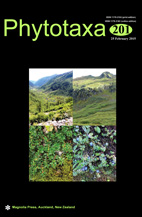Abstract
Nomenclatural and taxonomical considerations on Kali, a controversial genus recently segregated from the polyphyletic Salsola s. lat. (Chenopodiaceae), are provided. The Kali group includes annual plants with leaves ending in a spine and lacking hypodermis, having also a cortex alternate to longitudinal chlorenchymatous striae. The species belonging to this genus mainly have a paleotemperate distribution (Europe, Asia and North Africa), occurring as aliens in North America, Australia and South Africa. A new species collected on Mt. Etna (Sicily), and closely related to K. australe, is described and illustrated as K. basalticum Its morphological and molecular features, karyology (2n=54), ecology, distribution, phylogeny and conservation status are examined. In addition, a list of the currently known species of Kali is provided, with some new combinations: Kali nepalense (Grubov) comb. nov., Kali pellucidum (Litvinov) comb. nov., Kali sinkiangense (A.J. Li) comb. nov., Kali gobicolum (Iljin) comb. nov., and Kali ryanii (G.F. Hrusa & Gaskin) comb. nov.

